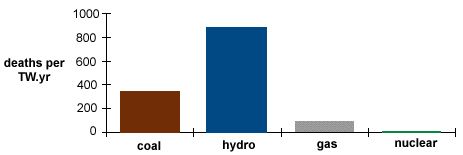Reconstructing nuclear confidence in post-Fukushima world is a long and painful process. But real-life energy demands especially in the developing countries predetermine a significant share of nuclear energy in their national energy consumption structure. Russian experience in this field can offer some interesting solutions to the decision-makers…
Fukushima incident has contributed a lot to the lay belief that nuclear energy use is a risk not worth taking. Although, according to the data of the non-profit World Nuclear Association only a very limited number of accidents occurred in over 14,500 cumulative reactor-years of commercial nuclear power operation in 32 countries. The Three Mile Island, Chernobyl and Fukushima are the most notorious examples of «Houston, we've had a problem» crisis situations. Is it possible to find balance between reasonable public concerns and nuclear generation crucial for economic growth? Russian experience in the reconstruction of global nuclear confidence can offer some interesting solutions to the post-Fukishima world.
Nuclear power use goes hand in hand with irrational fears especially in the so-called developed countries. A popular genre of post-apocalyptic drama (1) has been thrilling the Western consumers with pictures of polluted wastelands and toxic rains for several decades. No wonder Fukushima incident triggered the downfall of atomic industry in the EU: Germany adopted a total ban, Switzerland and Spain banned the construction of new reactors. Independent data analysis shows that the roots of these radical decisions lie in the sphere of crowd psychology – the politicians influenced by the green lobby had to stop the atomic panic. However, all energy specialists know: the impact of potential human errors in the nuclear sector has considerably decreased. According to the OECD report risk statistics, natural gas and nuclear industry appear to be the safest energy sources. The contrast is especially striking in comparison with other realistic energy options (see a timeline by The Guardian Datablog). «Of those we have identified, six accidents happened in the US and five in Japan. The UK and Russia have had three apiece», – Simon Rogers wrote counting accidents with nuclear reactors after the Japanese tragedy in 2011.

Source: Paul Scherrer Institut, 1998, considering 1943 accidents with more than 5 fatalities.
One TW.yr is the amount of electricity used by the world in about 5 months.
It explains why many sovereign governments like China, India and Iran want to see Russia’s Atomstroyexport as their contractor, despite the fact that they have their own peaceful atom programs. Last April Finnish Fennovoima also invited Atomstroyexport (along with Toshiba) to take part in a tender for building the sixth nuclear reactor in the country. The first two Finnish reactors were built by Russian specialists, the third and fourth by the Swedish company. The fifth reactor is now under construction by Germans and French.

Iranian facility in Bushehr is a unique example of engineering expertise. Russian specialists solved many technological problems and successfully integrated German structural elements into the new reactor. In the late 1990-es Siemens AG (Germany) quit the project mostly for political reasons, leaving behind tons of old hardware. Nevertheless, with the help of Iranian scientists the reactor of Bushehr nuclear power plant’s Unit 1 was brought up to 100 per cent of its projected capacity on August 30, 2012, the representative of Atomstroyexport announced last year. Setting all ideological considerations aside, the completion of the project in such highly seismic area was truly a landmark event for the whole industry. Bushehr facility successfully passed a harsh stress-test during the latest earthquake in Iran.
After 2011 Rosatom went global and concentrated on its key export project- the NPP-2006. Now this reactor combines both active and passive safety systems. Innovative solutions include advanced molten core catchers, passive heat decay removal system and other updated protection elements. At the same time US-Japanese and European companies are primarily developing passive nuclear safety systems because power outage reports influenced their risk analysis.
Earlier in the 20th century the Three Mile Island incident in the US (1979) lead to massive anti-nuclear protests and inspired the sociological theory of «system or normal accidents» by Charles B. Perrow, which both significantly slowed down the research in the US civil nuclear industry. In short, the theory holds that high-risk systems are prone to failures however well they were managed. Western companies simply lacked field data on various types of accident situations.
In contrast Russian specialists since Chernobyl have become really paranoid about disaster prevention and safety issues both on practical and theoretical level. For instance, Russian reactors can stand a direct collision with a falling plane – who could have ever expected it is necessary in the pre-9/11 world? If Rosatom’s modern NPP had been installed in Japan, Fukushima incident might not have happened. Or, at least, the consequences would have been not so devastating.
This year on April, 26 Russia mourned the 25th anniversary of the tragic events in Chernobyl. It was a painful lesson to learn. Russia has done its homework and now its nuclear power plants are the most reliable and technologically advanced atomic facilities on the market. One cannot but hope that politicians all over the world will understand that sometimes it is necessary to put safety concerns before lucrative business deals with politically «comfortable» partners. Paraphrasing one famous advertising motto, in the nuclear industry you should really get the best or nothing. Such strategy may help the decision-makers on nuclear projects to strike the happy medium between environmental concerns and actual energy demands.
(1)See, for example, famous book «The Road» by American novelist Cormac McCarthy and many other TV shows and computer games, not to mention Mr. Burns from «The Simpsons».









